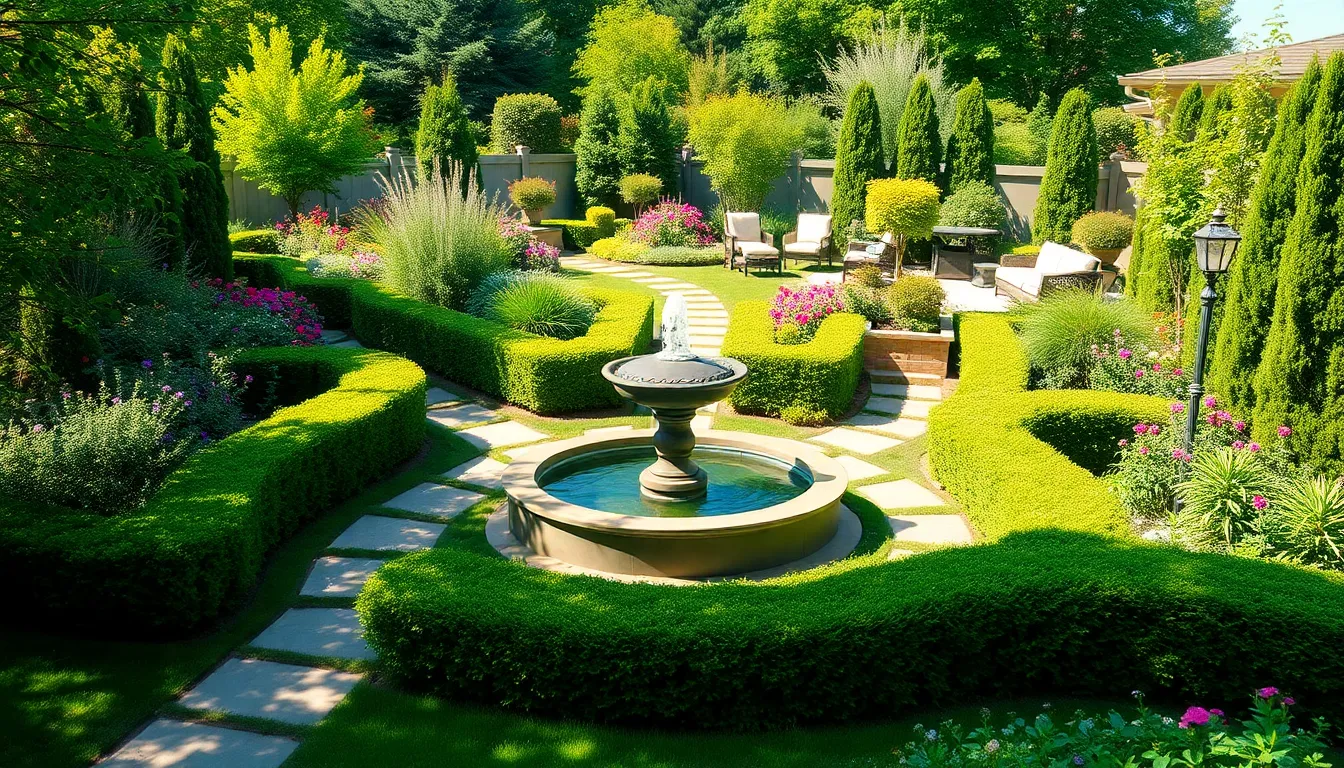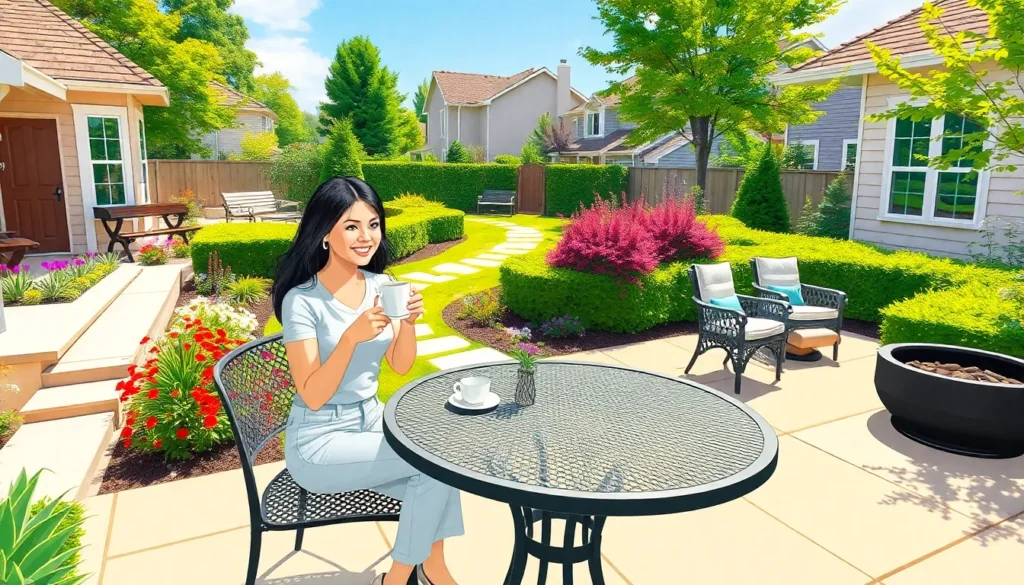Table of Contents
ToggleTransforming a yard into a stunning landscape is like turning a pumpkin into a carriage—magical and a little bit messy. Home landscape design isn’t just about planting flowers; it’s about creating a personal oasis that reflects one’s style. Imagine sipping coffee in a beautifully manicured garden while your neighbors squint in envy.
Overview of Home Landscape Design
Home landscape design transforms outdoor spaces into personalized retreats that reflect individual taste. This creative process enhances property appeal and maximizes enjoyment.
Importance of Landscape Design
Landscape design significantly impacts a home’s aesthetic and functional appeal. An inviting landscape boosts property value by 15% according to the National Association of Realtors. It creates an atmosphere where residents can relax and entertain guests seamlessly. Thoughtful design offers environmental benefits, such as improving air quality and providing habitats for wildlife. Emotional well-being often improves when outdoor spaces foster tranquility and connection to nature.
Key Elements of a Successful Landscape
Successful landscape design incorporates several key elements. Colorful plants capture attention and add vibrancy. Pathways lead visitors through the space, creating flow and accessibility. Features such as water elements or fire pits encourage social gatherings. Native plants enhance sustainability and minimize maintenance efforts. A mix of textures and shapes creates visual interest, making the landscape engaging year-round.
Types of Home Landscape Designs

Home landscape design offers various styles that cater to different tastes and environments. Understanding these types aids in selecting the right approach to achieve a personal retreat.
Formal Landscape Design
Formal landscape design emphasizes symmetry and structure, often featuring geometric shapes and well-defined pathways. This style includes neatly trimmed hedges, organized flower beds, and aligned trees. Water features, such as fountains or reflecting pools, often add elegance. Plants in formal designs frequently follow a specific color scheme or pattern, enhancing the overall order. By integrating features like columns or trellises, these gardens create a sense of grandeur and sophistication.
Informal Landscape Design
Informal landscape design focuses on natural beauty and spontaneity. It incorporates curved paths, varying plant heights, and a mix of textures. The aim is to create a relaxed atmosphere that feels inviting and unrestrained. Native plants often flourish in these settings, promoting biodiversity and low maintenance. Outdoor seating areas may blend seamlessly with the landscape, offering cozy spots for gatherings. This style appeals to individuals seeking comfort over formality while enhancing a home’s charm.
Xeriscaping and Sustainable Designs
Xeriscaping emphasizes water conservation while promoting sustainable practices. This design approach utilizes drought-resistant plants that thrive in dry climates. Incorporating elements such as mulch and efficient irrigation aids in reducing water usage. Sustainable designs include features like rain gardens, compost areas, and native plant selections, contributing to local ecosystems. By prioritizing environmental health, homeowners can create beautiful landscapes that require minimal resources and maintenance. These designs not only beautify properties but also foster a connection to nature and responsible stewardship.
Design Principles for Home Landscapes
Design principles form the backbone of effective home landscape design. They help create harmonious, functional spaces that enhance beauty and offer enjoyment.
Balance and Symmetry
Balance plays a crucial role in landscape design. It ensures that visual weight is distributed evenly, creating a sense of harmony. Symmetry can be striking, often seen in formal designs, where identical elements mirror each other on either side of a central axis. However, asymmetrical balance offers a more relaxed feel while maintaining equilibrium through varying shapes and sizes. Including focal points like sculptures or ornamental trees adds interest and directs the eye. Attention to balance and symmetry invites visitors to explore the landscape, enhancing the overall experience.
Color Theory and Plant Selection
Color theory influences the mood and energy of outdoor spaces. Warm colors, such as red and yellow, evoke warmth and excitement, while cool colors like blue and green promote calmness. Thoughtful plant selection based on color combinations can create striking visuals throughout different seasons. Grouping plants by color can enhance their impact, drawing attention to particular areas. Using complementary colors amplifies visual interest and creates dynamic contrasts in the landscape. Choosing varieties that bloom at different times ensures year-round color, enriching the home’s exterior while reflecting personal tastes.
Enhancing Functionality in Landscape Design
Functional landscape design elevates the usability of outdoor spaces while providing aesthetic appeal. The integration of thoughtful layouts enhances both relaxation and social interaction.
Creating Outdoor Living Spaces
Outdoor living spaces serve as extensions of the home. These areas can include patios, decks, and pergolas that encourage outdoor dining and lounging. By incorporating features like outdoor kitchens and seating areas, homeowners can create inviting environments for entertaining guests. Integrating fire pits increases warmth and comfort during cool evenings, further enriching the experience. Incorporating lush planting around these spaces adds beauty and privacy, making them even more enjoyable.
Incorporating Walkways and Lighting
Walkways enhance navigation and accessibility throughout the landscape. Materials like stone, gravel, or pavers offer durability and choose a style that complements the home’s architecture. In addition, proper lighting ensures safety and extends usability into the evening hours. Pathway lights, solar fixtures, and accent lighting can highlight features while creating ambiance. Incorporating lighting along walkways not only improves visibility but also showcases the beauty of the landscape after dark.
Creating a stunning home landscape design is an investment in beauty and functionality. It transforms outdoor spaces into personal retreats that reflect individual style while enhancing the overall property appeal. Thoughtful design choices can elevate both enjoyment and property value, making the outdoor environment a true extension of the home.
By incorporating elements like colorful plants, inviting pathways, and social features, homeowners can foster relaxation and connection with nature. Whether opting for a formal or informal approach, the key lies in balancing aesthetics with practicality. Ultimately, a well-designed landscape not only enriches the visual appeal but also promotes well-being and environmental sustainability, making every outdoor moment a cherished experience.




